
Doctor’s Island, Look Magazine 1963, Flyline Podcast with host Michael Jones interviewing Brad Burns, Miramichi spring salmon fishing prospects and how-to, more…
Fishing Friends
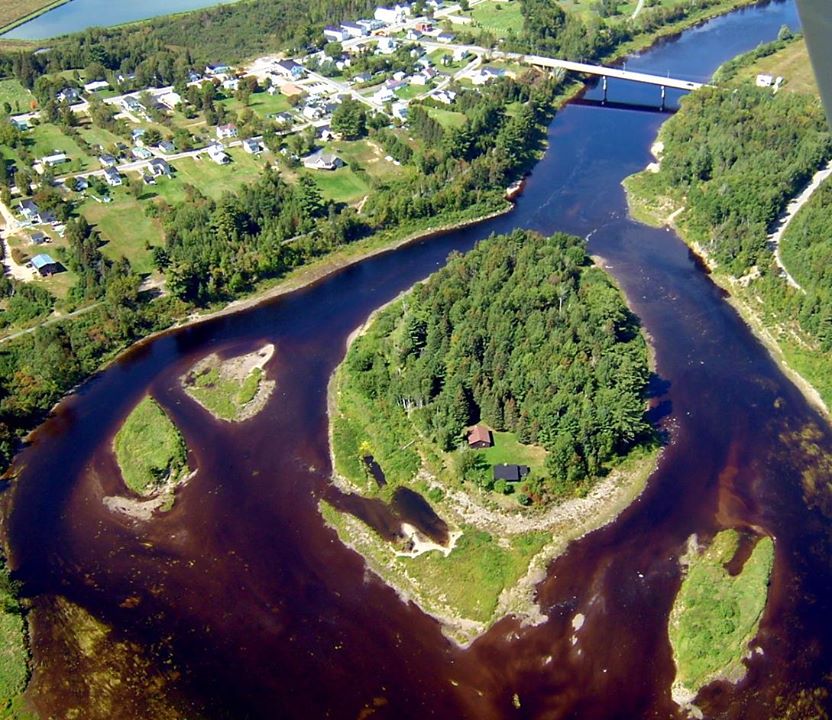
Doctor’s Island, with the old main lodge under the black roof at the lower center of the picture. Drone photo from Facebook post.
An old friend of mine, 2nd generation master Maine guide and a very talented Yankee character, Michael Jones, has a new venture called Fly Line Podcast – Maine Fishing Guides and Luminaries. I knew the first generation too, Michael’s father Dean, we worked together 50 years ago. This is a labor of love for Michael. He says that he is doing this podcast to build a legacy about Maine fishing that he will be proud to leave behind. The podcast is also no charge to the user/listener.
Recently Mike asked me if I would be a guest on Fly Line Podcast. It sounded like fun, so I accepted. Michael interviewed me about my life fishing, delving into striped bass as well as Atlantic salmon, and his Executive Producer and technical guru Sheri Maines edited out the stumbles and got the sound right.
If you go to the Fly Line Podcast link at 12:01 AM on February 28 – or any time thereafter – and click on Episodes, you will be able listen to the Brad Burns podcast. Michael has a few more already on the site, and he has more interviews set up, so this is a good resource for some listening pleasure when you can’t be on the water – please pass it around.
Someone once told me that fishermen start out by wanting to catch a lot of fish, then they graduate to wanting to catch big fish, and finally it is enough just to sniff the breeze blowing over a lovely stretch of fishing water. I wouldn’t say that I’m ready yet to be fully satisfied with sniffing the breeze, but I do love the aesthetics that go along with fishing, especially things that have to do with salmon rivers like the Miramichi and Cains Rivers.
One alluring place that I learned a lot about in writing On the Cains was Doctor’s Island. Just being an island, even one only separated from the mainland shores by water than you can wade through – in places and at times – offers some degree of isolation and protection that makes the place unique. Paul O’Haire, a restless, energetic man who studied classical music at Julliard in the 1930s and finally ended up both as a NYC advertising sales executive and the founder and owner of the Doctor’s Island Club left a fascinating footprint in Blackville, New Brunswick and created a lasting mark on the history of Miramichi salmon fishing.
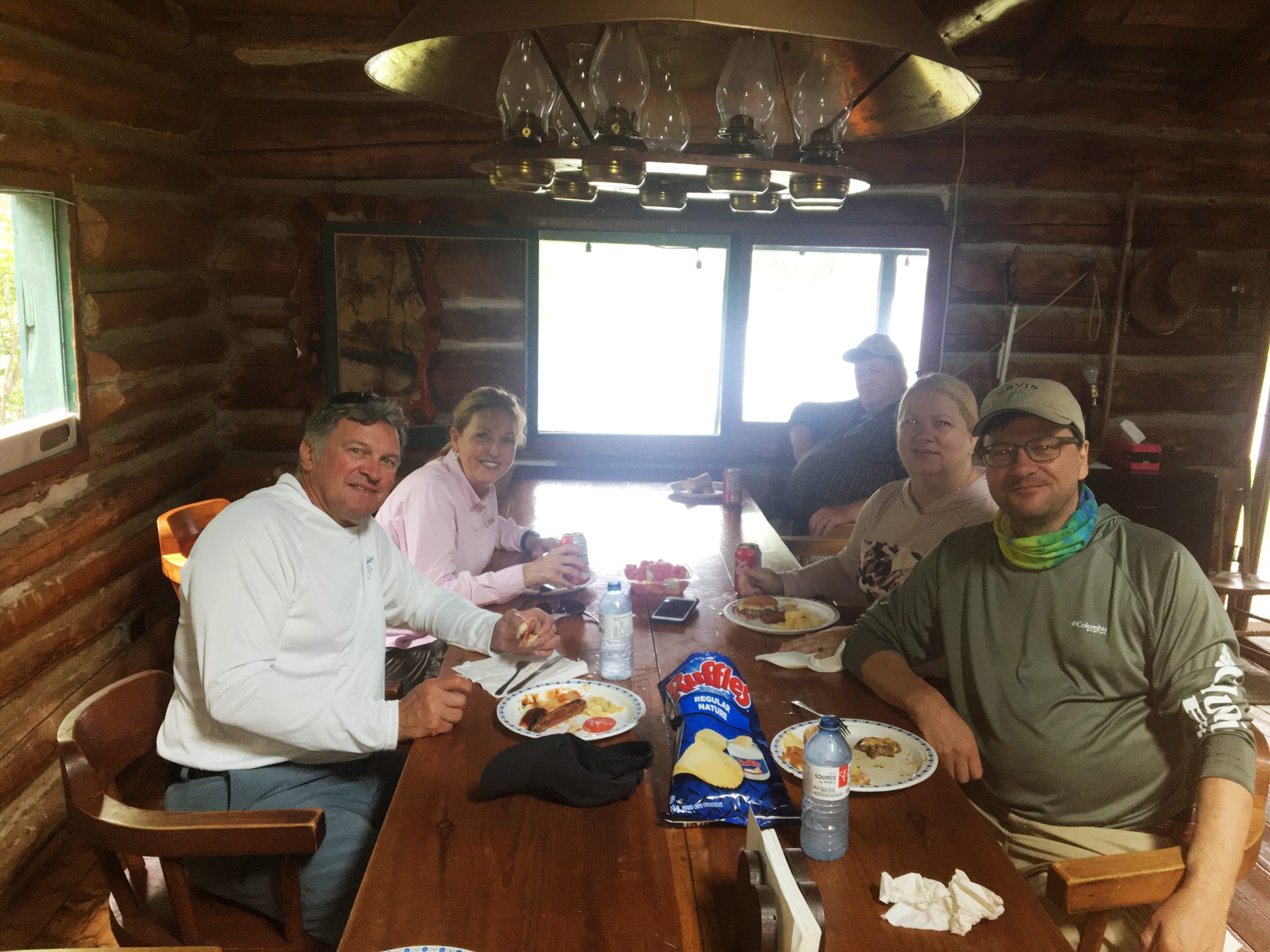
A lunch in support of the MSA in 2020. The table, window and light fixture are the same as in the early photograph taken 50 years ago.
Recently, out of nowhere, Dave O’Haire contacted me and ordered a couple of my books. I thought the last name was quite a coincidence but did not know he was the son of Paul O’Haire until it came out in e-mail conversation later. We’re just beginning to trade information, and already there is way too much for the scope of this blog. But one thing that Dave did tell me about was a 1963 issue of Look Magazine that had a story about a visit to the island by a couple of Paul’s friends from the advertising world in NYC.
This story includes one of Paul’s friends, Suren Ermoyan, who gained quite a bit of notoriety as Vice President of Lennon and Newell for his pioneering use of big-name celebrities of the day as personalities in extremely successful ads for American Airlines. Ermoyan and one of his buddies came up to visit Paul O’Haire at Doctor’s Island for a cast and blast.
I was able to scan a few pictures from the article and have included them here. They did catch salmon, and they also shot some grouse as well as black ducks which they referred to by the old-fashioned name of black mallards. Among Paul O’Haire’s many talents were his standing as a chef. Every story I have uncovered references the incredible food that graced the table at Doctor’s Island. That table, by the way, the chandelier over it, and the window at the far end, can still be seen in the summer of 2020 photograph. Thanks to the almost curator-level work of David Donahue, current proprietor of the lodge, things haven’t changed perceptibly in 50 years!
According to the Look Magazine article the lucky group feasted on “marinated wild black mallard ducks tended in port; braised partridge with crab apples and cabbage; salmon poached in court bouillion.” The warm-up for this feast was a lunch on the riverbank featuring a fat grilse tied to a plank stood in front of a shore-side fire. I hope my guests at Campbell’s Pool don’t expect this treatment!
More suspicious statements from DFO. The Canadian Department of Fisheries and Oceans recently stated that there was a “positive but statistically insignificant association” between the presence of the aquaculture facilities and sea lice infestations. The rest of the scientific community is aghast and has essentially jumped down the throats of the DFO scientists with this statement sent to DFO Minister Joyce Murray: “We note this so that it will not be taken lightly when we say that this report falls far short of the standards of credible independent peer review and publishable science,” DFO is the same organization that killed the much needed CAST program for no good reason at all and has continued to ham string efforts to supplement the Miramichi’s wild salmon fry to anything close to the level needed to mitigate the problems created by the out of control striped bass population. The Miramichi Salmon Association continues to try and work with DFO to implement the necessary actions to return the salmon population to the levels that were present just a few years ago.
What is Black Salmon fishing? Black salmon or slinks are derogatory names given to what Europeans call kelts – also a derogatory term over there. The names come from some salmon fishermen sticking their nose up at the idea of fishing for these fish that spawned the previous fall. The reality is kelts – or spring salmon as they are usually referred to on the Miramichi – at least in the early stages of their rebuilding, are far from the equal of a fat, chrome salmon returning from a full year or more of ocean feeding. They are still Atlantic salmon though, and come April they are feeding aggressively to rebuild for their next spawning run which in some cases can be that same year. In the wide world of fish there are few species out there that are better fighters than salmon kelts, and this is particularly true of the ones caught towards the middle of May after a month or so of active feeding.
There are also those who say that the kelts shouldn’t be fished for because release mortality could be high in their weakened state. This does not bear scrutiny, though, as release statistics show an almost imperceptibly low mortality. This is undoubtedly due to the oxygen-rich, ice-cold waters of springtime.
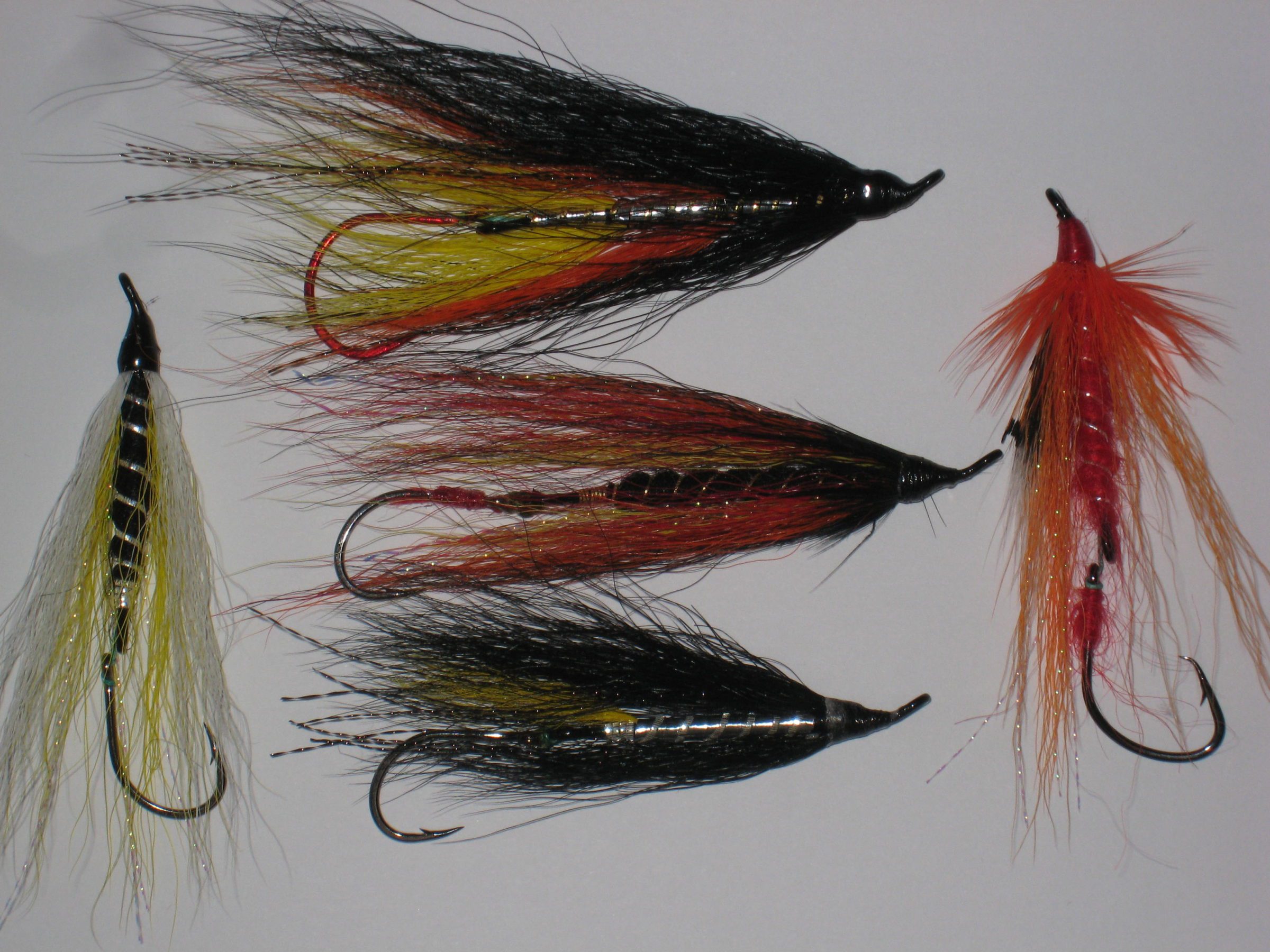
Some examples of large salmon flies that are perfect for spring salmon fishing. The Black Ghost, Comet, Willie Gunn, Black and Yellow, and Ally’s Shrimp are all good patterns. I like them tied on these Waddington shanks. The shank positions the hook well back on the fly and catches some of those “nippers” that might otherwise not be hooked.
Most spring salmon are caught on large flies and sink tip lines. Large flies are used because the rebuilding salmon are looking for a real meal, and sink tip lines are used to get the fly down near the bottom where the kelts are thought to be spending their time avoiding the fast-moving flows nearer the surface. This certainly seems logical, and I have caught lots of spring salmon that took flies dredged along the bottom. Just last spring, though, I was resting a fly on the surface, a leader’s length from the boat, while I considered where I was going to place my next cast. A salmon came up, and with a big splash took the fly right on the surface in 10 feet of water. That all happened on April 15, opening day!
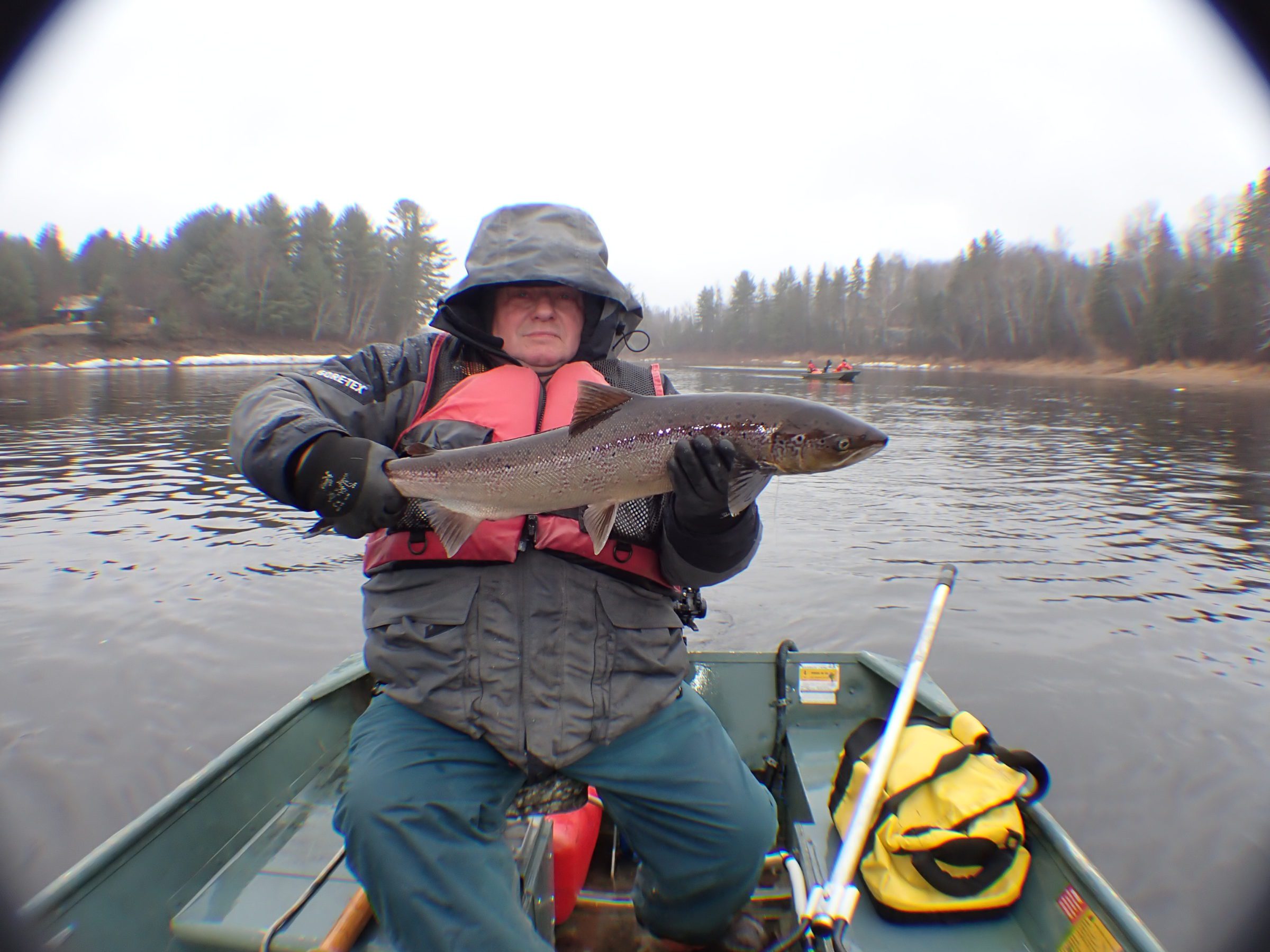
Guide Darrell Warren holds a typical Miramichi spring salmon. The old lodge on Doctor’s Island is on the left in the background.
To me, the biggest thing that you can do right in spring salmon fishing is to move the fly slowly. Find places, and use techniques like mending, to keep the fly moving slowly. At the end of the swing don’t immediately strip in, especially if you feel you are in an area holding a decent number of fish. Just let that fly swim in the current on a tight line. You don’t need to pump or twitch it either. I’ve had many of my strikes come when I made a long slow strip, then simply held the fly in position, sometimes for 15 or 20 seconds or more.
What can we expect for the spring salmon season of 2023? Salmon, as opposed to grilse, came off their third consecutive increase in numbers during 2022. There were good numbers of salmon to catch last spring, so there is every reason to hope that this year will also be good. Despite the current cold snap which is closing up the open leads that have persisted in the river ice all winter, conditions have been good with plenty of water. Over winter survival should be good.
How can you get in on the spring salmon action? Upper Oxbow Adventures over on the NW Miramichi and Country Haven, The Ledges and Wilson’s on the SWM offer spring salmon packages. These lodges and others are all listed on FishPal Miramichi along with other information about the fishing. This link https://www.fishpal.com/Canada/Miramichi/fisheries.html will take you to a list of all these fisheries and more. There is a lot of other information available on the site also. Doaks and Curtis Fly Shop in Blackville can both set you up with excellent spring salmon flies.
Thanks for reading! Brad Burns
PS The names to go along with the picture in your blog alert letter from L to R are Pat Boland from CT, Guido Mosca from NYC, and Bob Byles from Vancouver, CA.


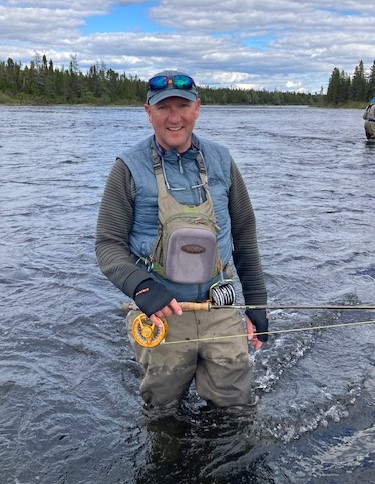
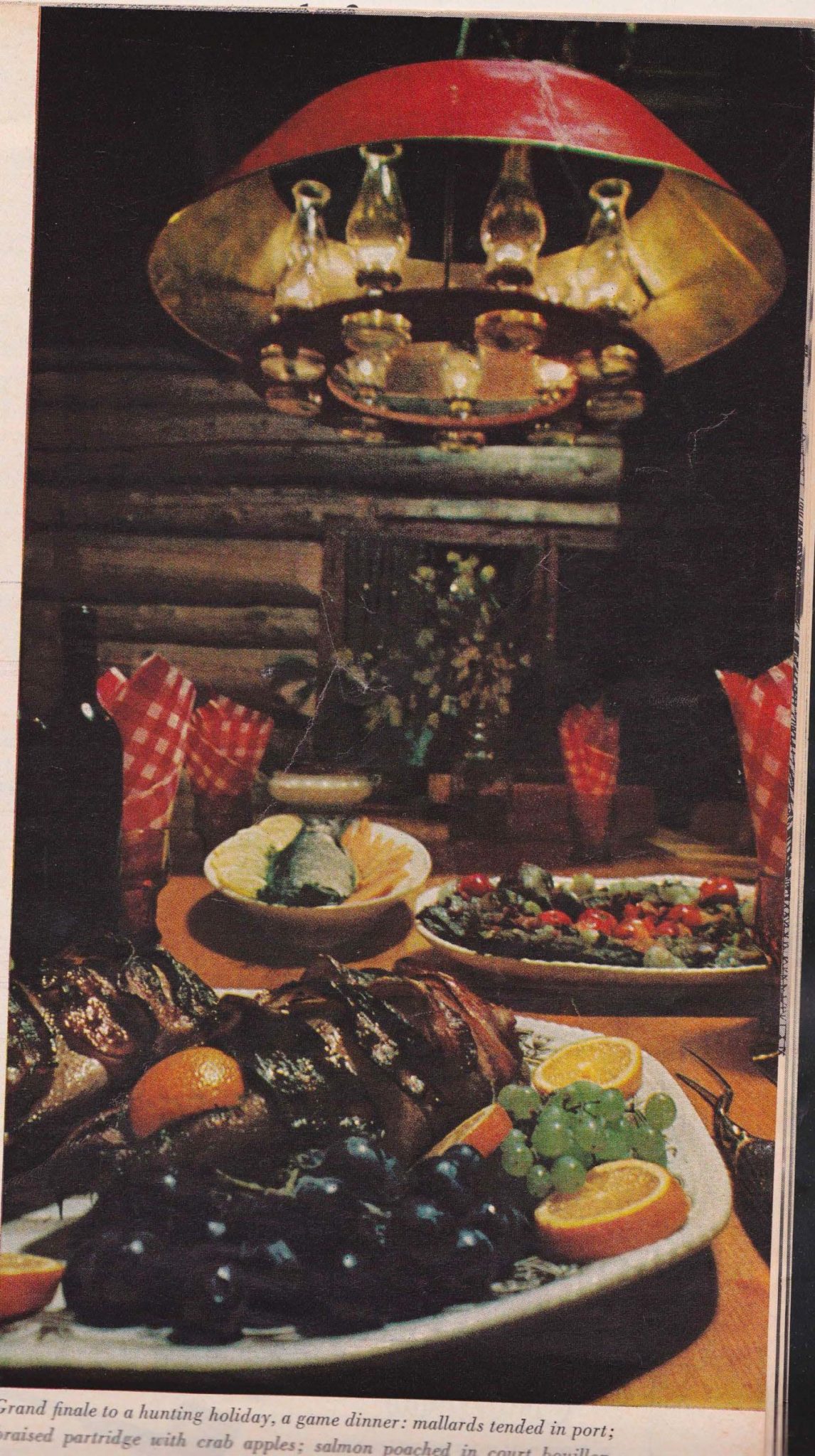


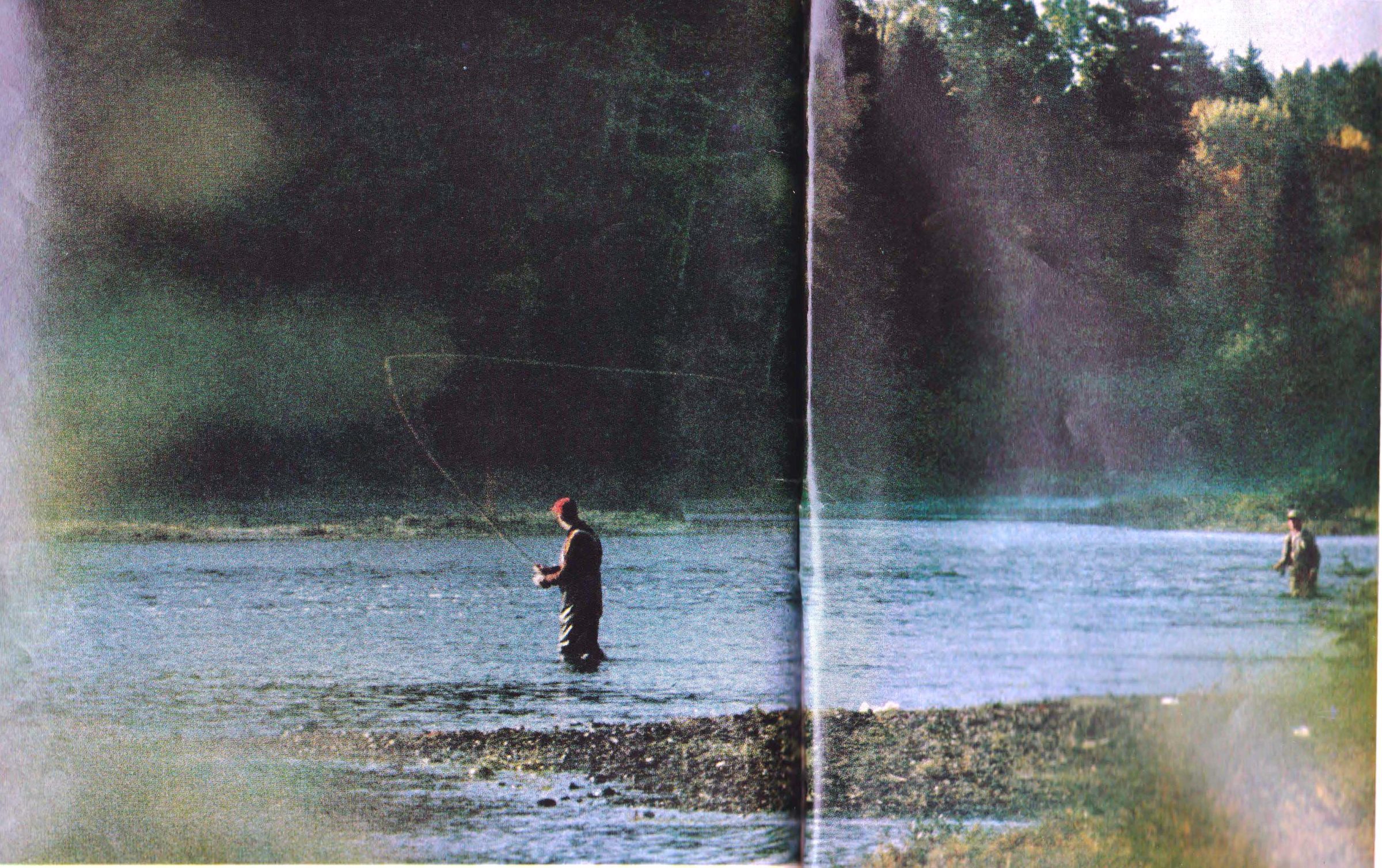
Brad,
As I think about my upcoming fishing trip this June to Country Haven with my two sons, I’m excited about my first return to fish for salmon in the Miramichi since I caught a grilse there in the summer of 1963 at the age of 11, I’m now 71. Reading your blogs each time increases my excitement, and I want to thank you for sustaining this excitement and motivation, particularly during the winter months. Thanks again!!!
Paul Nuccio from Massachusetts
Paul – I’ve got you beat by a year, but I regret that my youth contained no Atlantic salmon fishing. According to biologist Bill Hooper 1966 – I think – was the last great year on the Miramichi. The run then was estimated to be around 600K. The Miramichi experience is still wonderful, but I’d sure like to have seen some of those big runs.
great pictures of the good old days.Brad do you have a membership list[ as far back as possible} of Doctors Island.I believe several where friends of my dads,[Richard A Buck]Best John
Thanks John. Club and lodge records in general along the Miramichi are hard to come by. I always hear that the records were kept but at changing of the guard they seem to go home with someone and never return.
Always insightful, historical and great fishing pictures, well done Brad!
Thanks Phil, always great to hear from you. Brad
Thanks and … Tight lines on the Naver, Brad!
Brad,
Mike Jones is a wonderful and patient guide as well as an accomplished angler. I’ll be sure to tune in and listen to the podcast.
That’s great. Really good post. Your content is very use full.
Wow!!!This topic is very good. In one word, excellent. I like your work very much